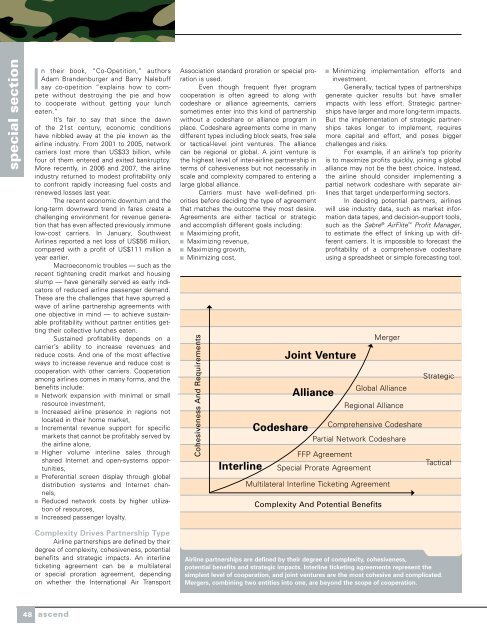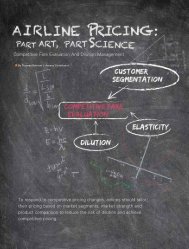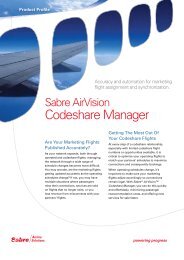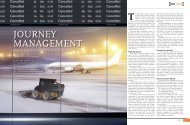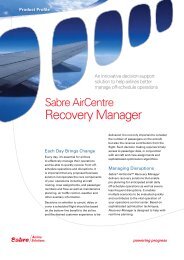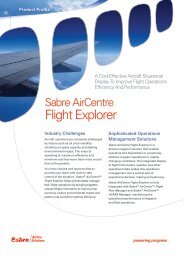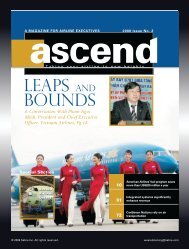2009 Issue 1 - Sabre Airline Solutions
2009 Issue 1 - Sabre Airline Solutions
2009 Issue 1 - Sabre Airline Solutions
You also want an ePaper? Increase the reach of your titles
YUMPU automatically turns print PDFs into web optimized ePapers that Google loves.
special section<br />
In their book, “Co-Opetition,” authors<br />
Adam Brandenburger and Barry Nalebuff<br />
say co-opetition “explains how to compete<br />
without destroying the pie and how<br />
to cooperate without getting your lunch<br />
eaten.”<br />
It’s fair to say that since the dawn<br />
of the 21st century, economic conditions<br />
have nibbled away at the pie known as the<br />
airline industry. From 2001 to 2005, network<br />
carriers lost more than US$33 billion, while<br />
four of them entered and exited bankruptcy.<br />
More recently, in 2006 and 2007, the airline<br />
industry returned to modest profitability only<br />
to confront rapidly increasing fuel costs and<br />
renewed losses last year.<br />
The recent economic downturn and the<br />
long-term downward trend in fares create a<br />
challenging environment for revenue generation<br />
that has even affected previously immune<br />
low-cost carriers. In January, Southwest<br />
<strong>Airline</strong>s reported a net loss of US$56 million,<br />
compared with a profit of US$111 million a<br />
year earlier.<br />
Macroeconomic troubles — such as the<br />
recent tightening credit market and housing<br />
slump — have generally served as early indicators<br />
of reduced airline passenger demand.<br />
These are the challenges that have spurred a<br />
wave of airline partnership agreements with<br />
one objective in mind — to achieve sustainable<br />
profitability without partner entities getting<br />
their collective lunches eaten.<br />
Sustained profitability depends on a<br />
carrier’s ability to increase revenues and<br />
reduce costs. And one of the most effective<br />
ways to increase revenue and reduce cost is<br />
cooperation with other carriers. Cooperation<br />
among airlines comes in many forms, and the<br />
benefits include:<br />
Network expansion with minimal or small<br />
resource investment,<br />
Increased airline presence in regions not<br />
located in their home market,<br />
Incremental revenue support for specific<br />
markets that cannot be profitably served by<br />
the airline alone,<br />
Higher volume interline sales through<br />
shared Internet and open-systems opportunities,<br />
Preferential screen display through global<br />
distribution systems and Internet channels,<br />
Reduced network costs by higher utilization<br />
of resources,<br />
Increased passenger loyalty.<br />
complexity Drives Partnership type<br />
<strong>Airline</strong> partnerships are defined by their<br />
degree of complexity, cohesiveness, potential<br />
benefits and strategic impacts. An interline<br />
ticketing agreement can be a multilateral<br />
or special proration agreement, depending<br />
on whether the International Air Transport<br />
48 ascend<br />
Association standard proration or special proration<br />
is used.<br />
Even though frequent flyer program<br />
cooperation is often agreed to along with<br />
codeshare or alliance agreements, carriers<br />
sometimes enter into this kind of partnership<br />
without a codeshare or alliance program in<br />
place. Codeshare agreements come in many<br />
different types including block seats, free sale<br />
or tactical-level joint ventures. The alliance<br />
can be regional or global. A joint venture is<br />
the highest level of inter-airline partnership in<br />
terms of cohesiveness but not necessarily in<br />
scale and complexity compared to entering a<br />
large global alliance.<br />
Carriers must have well-defined priorities<br />
before deciding the type of agreement<br />
that matches the outcome they most desire.<br />
Agreements are either tactical or strategic<br />
and accomplish different goals including:<br />
Maximizing profit,<br />
Maximizing revenue,<br />
Maximizing growth,<br />
Minimizing cost,<br />
Minimizing implementation efforts and<br />
investment.<br />
Generally, tactical types of partnerships<br />
generate quicker results but have smaller<br />
impacts with less effort. Strategic partnerships<br />
have larger and more long-term impacts.<br />
But the implementation of strategic partnerships<br />
takes longer to implement, requires<br />
more capital and effort, and poses bigger<br />
challenges and risks.<br />
For example, if an airline’s top priority<br />
is to maximize profits quickly, joining a global<br />
alliance may not be the best choice. Instead,<br />
the airline should consider implementing a<br />
partial network codeshare with separate airlines<br />
that target underperforming sectors.<br />
In deciding potential partners, airlines<br />
will use industry data, such as market information<br />
data tapes, and decision-support tools,<br />
such as the <strong>Sabre</strong> ® AirFlite Profit Manager,<br />
to estimate the effect of linking up with different<br />
carriers. It is impossible to forecast the<br />
profitability of a comprehensive codeshare<br />
using a spreadsheet or simple forecasting tool.<br />
<strong>Airline</strong> partnerships are defined by their degree of complexity, cohesiveness,<br />
potential benefits and strategic impacts. Interline ticketing agreements represent the<br />
simplest level of cooperation, and joint ventures are the most cohesive and complicated.<br />
Mergers, combining two entities into one, are beyond the scope of cooperation.


